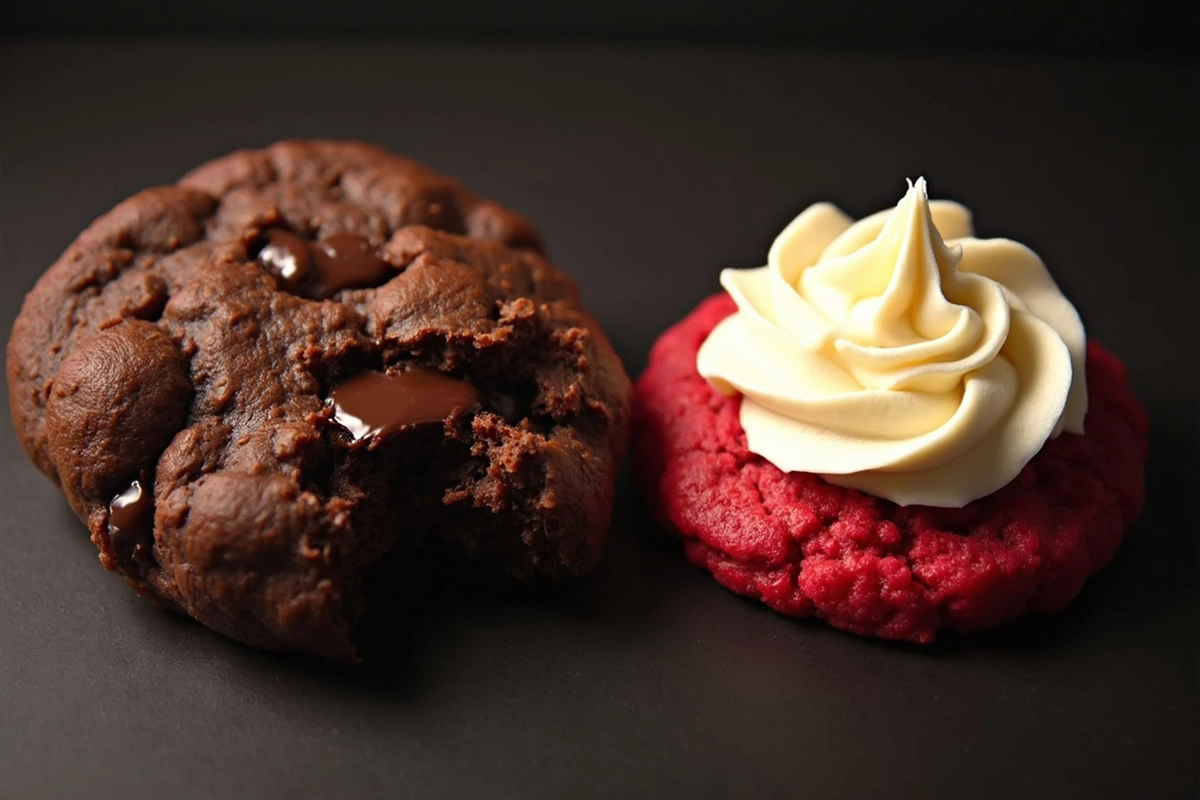Cookies are among the most beloved treats globally, but few realize the significant differences between chocolate cookies and red velvet cookies. While both are incredibly delicious, their distinct flavors, ingredients, and textures set them apart. This comprehensive guide will delve into those differences, providing insights into the unique qualities of each.
Introduction to Chocolate and Red Velvet Cookies
Chocolate cookies are a classic that many people love. They are rich, indulgent, and bursting with cocoa flavors. On the other hand, red velvet cookies offer a more complex taste profile, with subtle hints of cocoa paired with a tangy, creamy undertone that sets them apart from traditional chocolate cookies.
While many may confuse the two, especially due to the presence of cocoa in both, their overall composition and flavor make them stand out. To truly understand the differences, it’s essential to dive into their ingredients, flavors, textures, and baking processes.
Historical Background
The origins of chocolate cookies can be traced back to the first chocolate chip cookies, created by Ruth Wakefield in the 1930s. These cookies quickly became an American favorite. In contrast, red velvet cookies evolved from the iconic red velvet cake, which gained popularity in the 20th century, particularly in the Southern United States.
Red velvet cake was initially famous for its unique red hue, which came from a reaction between cocoa and vinegar in the batter. Today, food coloring is typically used to achieve the bright red color, but the tradition of pairing red velvet flavors with cream cheese frosting has continued, influencing the creation of red velvet cookies.3
Key Ingredients in Chocolate Cookies
Chocolate cookies rely heavily on rich, high-quality cocoa powder, which provides their deep, bold flavor. Here are the primary ingredients:
- Cocoa powder: The foundation of a chocolate cookie’s flavor.
- Butter or oil: Helps create a chewy texture.
- Sugar: Balances the bitterness of cocoa and adds sweetness.
- Eggs: Binds the ingredients together and contributes to the structure.
- Flour: Provides the necessary base for cookie dough.
These ingredients work together to create a cookie that’s rich in flavor and texture. Many variations of chocolate cookies include dark chocolate chips, nuts, or even sea salt to enhance their indulgent nature.
Key Ingredients in Red Velvet Cookies
On the other hand, red velvet cookies have a more complex ingredient list that distinguishes them from their chocolate counterpart. While they do contain cocoa powder, it’s in much smaller amounts, allowing other flavors to shine through. Here are the key ingredients:
- Cocoa powder: Adds a subtle chocolatey flavor but is not the star ingredient.
- Buttermilk: Provides a tangy flavor, adding complexity to the cookie.
- Vinegar: Reacts with cocoa and buttermilk to give a slight tang and fluffiness.
- Red food coloring: Enhances the signature red hue of red velvet.
- Cream cheese filling or topping (optional): A common addition that complements the tanginess of the cookie.
This combination results in a soft, velvety cookie with hints of cocoa, but the overall flavor is more nuanced due to the inclusion of buttermilk and vinegar.
Differences in Texture
One of the most noticeable differences between chocolate and red velvet cookies lies in their textures.
- Chocolate cookies: These are often chewy with a slight crisp around the edges. The high cocoa content and use of butter or oil give them a dense, rich texture.
- Red velvet cookies: These tend to have a softer, almost cake-like texture, thanks to the inclusion of buttermilk and vinegar. The acidity of these ingredients reacts with the baking soda to create a fluffier, lighter cookie.

Flavor Differences: Red Velvet Cookies vs Chocolate Cookies
The flavor difference between chocolate cookies and red velvet cookies is also significant.
- Chocolate cookies: These offer a strong, bold cocoa flavor, which can be complemented by various types of chocolate, such as dark or milk chocolate. The bitterness of cocoa is typically balanced with sugar, resulting in a sweet yet rich taste.
- Red velvet cookies: The flavor here is more subtle. While they contain cocoa, the presence of buttermilk and vinegar gives them a tangy, slightly acidic taste. The result is a balanced cookie that is not as overpoweringly chocolatey as its counterpart.
While both cookies share cocoa powder, their overall taste is vastly different due to the other ingredients used in the recipe.
Popular Variations and Mix-ins
Both chocolate and red velvet cookies lend themselves well to variations, with bakers often adding different mix-ins to enhance their flavors.
- Chocolate cookie variations:
- Dark chocolate chips for added richness.
- White chocolate chips for a contrast in flavor and color.
- Nuts such as pecans or walnuts for texture.
- Sea salt to balance the sweetness.
- Red velvet cookie variations:
- White chocolate chips, which complement the tangy flavor of red velvet.
- Cream cheese filling to replicate the traditional cream cheese frosting of red velvet cake.
- Sprinkles or red sugar for added visual appeal.
Baking Techniques and Challenges
When it comes to baking these two types of cookies, the techniques and potential challenges are different.
- Chocolate cookies: To get a chewy texture, it’s essential to use the right amount of butter and sugar. Too much flour can lead to a dry cookie, so careful measuring is key. Additionally, chilling the dough before baking can help prevent spreading and create a thicker, chewier cookie.
- Red velvet cookies: The challenge here is maintaining the balance between the tanginess from the buttermilk and vinegar and the sweetness. It’s also essential to monitor the amount of red food coloring used, as too much can result in a bitter taste.
Nutritional Comparison
Both cookies are decadent treats, but their nutritional content differs.
- Chocolate cookies: Higher in fat due to the use of butter and chocolate. They tend to have more calories per cookie, especially if additional chocolate chips or mix-ins are added.
- Red velvet cookies: These are slightly lighter in texture but can still be calorie-dense, especially when cream cheese fillings or white chocolate chips are included.
For those who are health-conscious, portion control is key for both cookie types.
For more in-depth information on what sets red velvet apart from other flavors, you can read Food & Wine’s article on the difference between chocolate and red velvet cakes. If you’re curious about how cocoa works differently in both recipes, check out King Arthur Baking’s guide to baking with cocoa powder.
FAQs about the Difference Between Chocolate and Red Velvet Cookies
Q: Can I use the same cocoa powder for chocolate and red velvet cookies?
A: Yes, but keep in mind that red velvet cookies typically require less cocoa powder to maintain their signature color and flavor.
Q: What gives red velvet cookies their distinct color?
A: Traditionally, the reaction between cocoa powder and vinegar caused a reddish hue, but today, most bakers use red food coloring.
Q: Why do red velvet cookies include vinegar and buttermilk?
A: These ingredients add a tangy flavor and help make the cookies soft and tender by reacting with the baking soda.
Q: Are red velvet cookies sweeter than chocolate cookies?
A: Not necessarily. Red velvet cookies have a more subtle sweetness due to the tangy buttermilk and vinegar, while chocolate cookies often have a more pronounced sweetness from sugar and chocolate.
Conclusion
In conclusion, while chocolate cookies and red velvet cookies share some similarities, their differences in ingredients, texture, and flavor make each one unique. Whether you prefer the bold, rich taste of chocolate or the tangy, nuanced flavor of red velvet, both types of cookies offer something special. So, next time you’re deciding between the two, you can appreciate the distinct qualities that make each one a delicious treat in its own right.
For a more detailed comparison of red velvet and chocolate desserts, you can also read our article on the difference between red velvet and chocolate cake. If you’re curious about how cocoa works differently in both recipes, check out King Arthur Baking’s guide to baking with cocoa powder.

